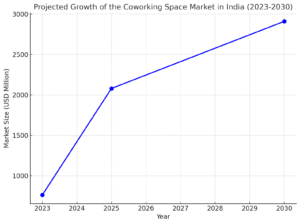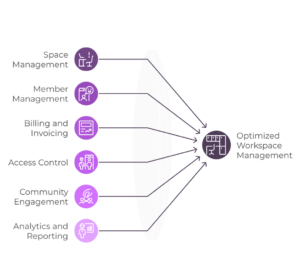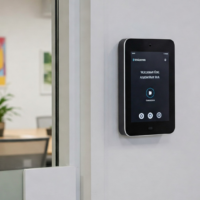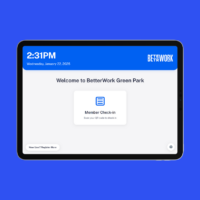The co-working industry in India has witnessed remarkable growth in recent years, presenting a lucrative opportunity for entrepreneurs. The market size was estimated at INR 5,000 crore in FY2023 and is projected to reach INR 12,000 crore by FY2031, growing at a CAGR of 13.47% during the forecast period FY2024-FY2031.
This comprehensive guide provides detailed insights and actionable steps to help you establish a successful co-working space in India.
1. Understanding the Indian Co-Working Market
Before diving into the establishment of a co-working space, it’s crucial to understand the current market landscape.
- Market Growth: The Indian co-working space market is experiencing rapid expansion, with projections indicating significant growth in the coming years.
- Demand Drivers: The surge in demand is primarily driven by startups, freelancers, and SMEs seeking flexible and cost-effective workspace solutions. Additionally, large enterprises are increasingly adopting co-working spaces to accommodate flexible work arrangements.
- Geographical Distribution: Major metropolitan cities like Bengaluru, Mumbai, and Delhi-NCR are leading the co-working space adoption. However, there’s a growing trend towards expansion in Tier 2 and Tier 3 cities, driven by the rise of startups and remote work culture.

2. Crafting a Robust Business Plan
A well-structured business plan serves as the foundation for your co-working venture.
- Executive Summary: Provide a concise overview of your business idea, mission statement, and objectives.
- Market Analysis: Utilize the insights from the market overview to detail your target demographics, market needs, and how your co-working space will meet these demands.
- Services and Amenities: Clearly define the range of services and amenities your co-working space will offer, such as high-speed internet, meeting rooms, event spaces, and community programs. This includes flexible membership plans such as:
- Community Plan: Access to the virtual community and all events.
- Hot Desk Plan: 8-20 days a month of hot desk use, 5-10 hours of meeting room rentals.
- Private Office: 24/7 access to a secure office, meeting room rental allocation.
- Virtual Mail Plan: Access to virtual mail services and discounts on meeting rooms and desk bookings.
- Pricing Your Membership Plans How you price these plans will depend on several factors:
- Market Research: Assess competitors in your local area and their pricing structures. Understand what features they offer and how you can differentiate your pricing strategy.
- Amenities: The level of amenities you provide (e.g., internet speed, meeting rooms, printing services, refreshments, etc.) will impact pricing. Higher-end facilities or specialized services like mentorship programs or wellness features might justify higher pricing.Profitability Goals: Consider how much revenue you need to generate each month to cover operating expenses (rent, utilities, staff salaries) and turn a profit. Your pricing should be designed to meet these goals while remaining competitive in the market.
- Financial Projections: It’s essential to provide a detailed breakdown of the costs involved in setting up your co-working space. This includes initial setup costs (such as real estate, furniture, technology), operational expenses, and projected revenue streams. Make sure to calculate how long it will take to break even, the pricing models you plan to use, and your expected return on investment (ROI).
- Marketing and Sales Strategy: Develop a plan to attract and retain members. Consider digital marketing channels like social media, SEO, and online advertising. Additionally, implement referral programs and partnerships with local businesses. Tailor your sales tactics to suit different customer segments, from large corporations needing office space to freelancers looking for a community-driven environment.
- Operational Plan: This section outlines how the co-working space will run on a day-to-day basis. It should describe your staffing requirements, organizational structure, and key responsibilities. Consider what operational software and tools you will use, such as DeskOS, to manage memberships, bookings, billing, and more.
3. Selecting the Ideal Location
The location of your co-working space is crucial to its success. A prime location will attract a steady stream of members, while the wrong location can limit growth potential.
- Accessibility: Choose a location that is easy for members to reach. Consider proximity to major transportation hubs, such as metro stations, bus stops, and airports. Accessibility is a key factor that will influence membership retention.
- Proximity to Business Hubs: A location close to business hubs, commercial areas, or tech parks will increase your chances of attracting clients looking for networking opportunities. Members may prefer a space that provides access to other businesses in their industry or complements their work ecosystem.
- Real Estate Costs: Prime locations come with higher real estate costs. While it is essential to secure a strategic location, you must ensure that the lease and operational costs are in line with your financial projections and business model. Weigh the benefits of a high-traffic area against the overhead costs it brings.
- Local Competition: Evaluate the co-working space market in the area. If there are several existing spaces, assess their offerings, pricing, and occupancy rates. You may need to position your space differently to create a unique value proposition or cater to a niche market.
4. Designing an Engaging Workspace
The design and ambiance of your co-working space play a pivotal role in attracting and retaining members.
- Flexible Layout: Incorporate a mix of private offices, open desks, meeting rooms, and collaborative areas to cater to diverse client needs.
- Ergonomic Furniture: Invest in comfortable and functional furniture to enhance productivity and well-being.
- Aesthetics: Utilize appealing color schemes, artwork, and interior design elements to create an inviting atmosphere.
- Natural Light and Ventilation: Ensure ample natural light and proper ventilation to promote a healthy work environment.
5. Legal and Regulatory Requirements
Compliance with legal and regulatory standards is essential to operate smoothly.
- Business Registration: Register your business entity under the appropriate legal structure (e.g., sole proprietorship, partnership, or private limited company).
- Licenses and Permits: Obtain necessary licenses such as the Shops and Establishment License, GST registration, and Fire Safety Certificate.
- Lease Agreements: If leasing property, ensure the agreement permits the operation of a co-working space and complies with local zoning laws.
- Insurance: Secure adequate insurance coverage, including property insurance and liability insurance, to protect against potential risks.

6. Implementing Advanced Technology Solutions
Integrating technology enhances operational efficiency and member experience.
- Co-Working Management Software: Utilize platforms like DeskOS to manage bookings, billing, member communication, and resource allocation seamlessly.
- High-Speed Internet: Provide reliable and fast internet connectivity, a non-negotiable requirement for all members.
- Access Control Systems: Implement secure access systems, such as key cards or biometric scanners, to ensure member safety.
- IoT Devices: Consider incorporating smart devices to monitor and control lighting, temperature, and security systems efficiently.
7. Developing an Effective Marketing Strategy
A strong marketing strategy will help your co-working space attract and retain members. It’s essential to focus on creating brand awareness and building a community around your space.
- Digital Presence: Build a professional website that clearly communicates your offerings, pricing, and unique features. Keep it up-to-date with relevant content, such as testimonials and success stories, to engage potential clients.
- Content Marketing: Publish blogs, case studies, and white papers that highlight your expertise in the co-working industry. This will not only establish your brand as an authority but also improve your visibility in search engines through SEO.
- Search Engine Optimization (SEO): Optimize your website for search engines by using relevant keywords. This will help you rank higher on search results, making it easier for potential clients to find your co-working space.
- Community Events: Hosting workshops, networking events, and seminars is a great way to engage with the local community. Events provide networking opportunities for members and help attract new clients who might be interested in your space.
8. Defining Your Target Market
Defining your target market or ideal customer profile (ICP) is a fundamental part of starting any business, including a co-working space. This step ensures that your offerings align with the needs and desires of your potential clients, making your marketing strategies more effective.
- Demographics: Consider the demographic profile of your ideal customer. Are they young professionals in their 20s and 30s? Are they entrepreneurs, freelancers, or employees from established businesses? Understand their occupation, income levels, and other key demographic factors.
- Psychographics: What do your target clients care about? What motivates them to seek flexible workspaces? Do they value networking opportunities, flexibility, or cost-effectiveness? Understanding their pain points and needs will help you design a space that appeals to them.
Example:- Cares About: Collaboration opportunities, networking, access to amenities like high-speed internet, and a professional environment for their business growth.
- Problems: Lack of a professional working space, isolation from not being part of a team or network, and the need for affordable office space with flexible terms.
- Why They Want a Co-Working Space: Understand the reasons behind their interest in co-working spaces. Are they tired of working from home and looking for a change of environment? Do they need an office space without the hassle of long-term leases? Or are they seeking a community of like-minded professionals to collaborate and network with?
Example:- Reasons for Choosing Co-Working: Seeking professional and collaborative workspaces, need for flexibility, desire for networking and growth opportunities, cost savings compared to traditional office spaces.
9. Ensuring Financial Sustainability
Maintaining financial health is crucial for the longevity of your co-working space.
- Diverse Revenue Streams: Beyond membership fees, consider additional income sources such as event hosting, virtual office services, and partnerships with local businesses.
- Cost Management: Monitor expenses diligently, negotiate favorable terms with suppliers, and optimize resource utilization to control costs.
- Membership Retention: Focus on retaining existing members through exceptional service, as acquiring new clients can be more costly than retaining current ones.
10. Planning for Future Expansion
Strategic planning for growth ensures long-term success.
- Scalability: Design your initial space with scalability in mind, allowing for easy expansion as demand increases.
- Market Trends: Stay informed about industry trends and evolving client needs to adapt your offerings accordingly.
- Diversification: Explore opportunities to diversify services, such as offering specialized workspaces for specific industries or incorporating co-living spaces.
Establishing a successful coworking space in India requires not only strategic planning but also a deep understanding of the challenges and best practices within the industry. By learning from existing successful coworking spaces and addressing common obstacles, you can enhance the value and insights of your venture.
Case Studies of Successful Coworking Spaces in India
- WeWork India: Since achieving profitability in 2021, WeWork India has expanded to over 8 million square feet across 57 locations in 8 cities. Their inclusive features, such as gender-neutral restrooms and startup-friendly offerings through WeWork Labs, have set them apart in the market.
- Awfis: Founded in 2015, Awfis has grown to operate in 16 cities across India, offering flexible workspace solutions. Their strategic partnerships and premium workspace offerings have contributed to their rapid expansion and success.
Best Practices for Enhancing Member Experience
- Community Building: Foster a sense of community through regular events, workshops, and networking opportunities.
- Flexible Membership Options: Offer various membership plans, including hot desking, dedicated desks, and private offices, to cater to diverse needs.
- Advanced Amenities: Provide high-speed internet, ergonomic furniture, and other essential amenities to enhance comfort and productivity.
- Sustainability Initiatives: Incorporate eco-friendly practices, such as energy-efficient lighting and waste reduction programs, to appeal to environmentally conscious members.
Introducing DeskOS
DeskOS is a comprehensive platform designed to simplify the complexities of running a coworking space.
Key Features of DeskOS:
- Space Management: Efficiently manage bookings for desks, private offices, and meeting rooms, optimizing workspace utilization.
- Member Management: Maintain detailed member profiles, track memberships, and facilitate seamless communication.
- Billing and Invoicing: Automate billing processes, generate invoices, and manage payments with ease.
- Access Control: Integrate with hardware solutions like turnstiles and kiosks to ensure secure and seamless access for members.
- Community Engagement: Foster a vibrant community through event management tools, discussion forums, and networking features.
- Analytics and Reporting: Gain insights into space utilization, member preferences, and financial performance to make informed decisions.

Benefits of Using DeskOS:
- Operational Efficiency: Automate routine tasks, reduce manual errors, and save time.
- Enhanced Member Experience: Provide members with a seamless experience, from booking spaces to attending events.
- Scalability: Easily scale operations as your coworking space grows, adding new locations or services without operational bottlenecks.
- Data-Driven Decisions: Utilize analytics to understand trends, optimize pricing, and improve services based on member feedback.
Incorporating DeskOS into your coworking space management strategy can significantly alleviate the complexities associated with daily operations, allowing you to focus on fostering a thriving coworking community.
Conclusion
By learning from successful coworking spaces and proactively addressing common challenges, you can create a dynamic and appealing environment for your members. Implementing best practices and leveraging advanced management tools like DeskOS will position your coworking space for sustained success in India’s evolving workspace landscape.





